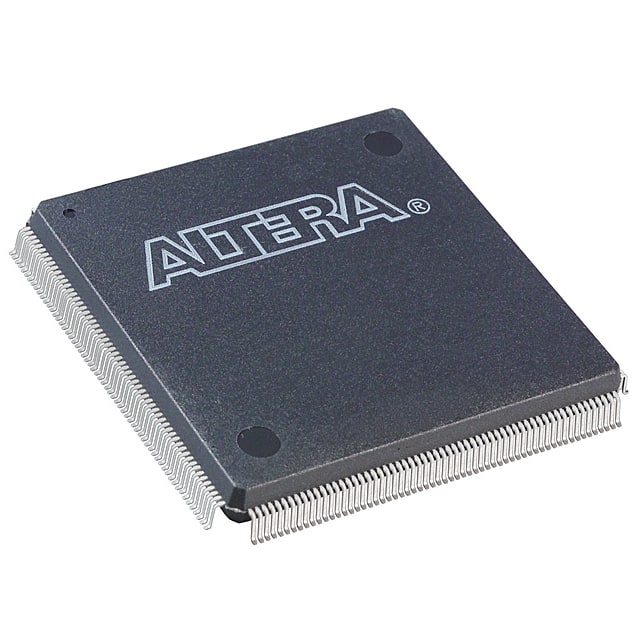Viz Specifikace pro podrobnosti o produktu.

EPF10K50VQC240-1
Product Overview
Category
The EPF10K50VQC240-1 belongs to the category of programmable logic devices (PLDs).
Use
This product is commonly used in digital circuit design and implementation. It provides a flexible and customizable solution for various applications.
Characteristics
- Programmable: The EPF10K50VQC240-1 can be programmed to perform specific functions based on user requirements.
- Versatile: It supports a wide range of applications due to its programmability.
- High-density: This PLD offers a high number of logic elements, making it suitable for complex designs.
- Low power consumption: The EPF10K50VQC240-1 is designed to operate efficiently with minimal power consumption.
Package
The EPF10K50VQC240-1 comes in a quad flat pack (QFP) package, which ensures easy integration into circuit boards.
Essence
The essence of this product lies in its ability to provide a reconfigurable hardware platform that allows users to implement custom logic functions.
Packaging/Quantity
The EPF10K50VQC240-1 is typically packaged in reels or trays, with quantities varying depending on customer requirements.
Specifications
- Logic Elements: 50,000
- Maximum Frequency: 240 MHz
- I/O Pins: 240
- Operating Voltage: 3.3V
- Package Type: QFP
- Temperature Range: -40°C to +85°C
Detailed Pin Configuration
The EPF10K50VQC240-1 has a total of 240 pins, each serving a specific purpose in the device's functionality. A detailed pin configuration diagram can be found in the product datasheet.
Functional Features
- Reconfigurability: The EPF10K50VQC240-1 allows users to modify the logic functions it performs, enabling flexibility in design.
- High-Speed Operation: With a maximum frequency of 240 MHz, this PLD can handle complex operations efficiently.
- I/O Flexibility: The device offers 240 I/O pins, providing ample connectivity options for interfacing with other components.
Advantages and Disadvantages
Advantages
- Customizability: The EPF10K50VQC240-1 enables designers to create tailored solutions for specific applications.
- Cost-effective: By eliminating the need for dedicated hardware, this PLD reduces overall system costs.
- Time-saving: Reconfigurability allows for faster prototyping and design iterations.
Disadvantages
- Learning Curve: Utilizing programmable logic devices requires knowledge of hardware description languages and digital design concepts.
- Limited Resources: The number of logic elements and I/O pins may not be sufficient for extremely complex designs.
Working Principles
The EPF10K50VQC240-1 operates based on the principles of field-programmable gate arrays (FPGAs). It consists of an array of configurable logic blocks interconnected through programmable interconnects. These logic blocks can be programmed to perform various logic functions, allowing for the implementation of custom digital circuits.
Detailed Application Field Plans
The EPF10K50VQC240-1 finds applications in various fields, including: - Telecommunications: Used in network equipment, routers, and switches. - Industrial Automation: Employed in control systems, motor drives, and robotics. - Consumer Electronics: Integrated into gaming consoles, set-top boxes, and multimedia devices. - Automotive: Utilized in automotive electronics, such as engine control units and infotainment systems.
Detailed and Complete Alternative Models
- Xilinx XC9500XL series
- Altera MAX 7000 series
- Lattice ispMACH 4000 series
- Microchip ATF150x series
These alternative models offer similar functionality and can be considered as alternatives to the EPF10K50VQC240-1.
Word count: 536
Seznam 10 běžných otázek a odpovědí souvisejících s aplikací EPF10K50VQC240-1 v technických řešeních
Sure! Here are 10 common questions and answers related to the application of EPF10K50VQC240-1 in technical solutions:
1. What is EPF10K50VQC240-1? EPF10K50VQC240-1 is a programmable logic device (PLD) manufactured by Intel. It belongs to the EPF10K family of PLDs and has 50,000 usable gates.
2. What are the typical applications of EPF10K50VQC240-1? EPF10K50VQC240-1 can be used in various applications such as industrial automation, telecommunications, automotive systems, medical equipment, and consumer electronics.
3. What are the key features of EPF10K50VQC240-1? Some key features of EPF10K50VQC240-1 include high-density programmable logic, on-chip memory, embedded multipliers, and support for various I/O standards.
4. How can EPF10K50VQC240-1 be programmed? EPF10K50VQC240-1 can be programmed using the Quartus II software provided by Intel. The programming file can be loaded onto the device using a JTAG programmer.
5. What is the maximum operating frequency of EPF10K50VQC240-1? The maximum operating frequency of EPF10K50VQC240-1 depends on the specific design and implementation. However, it can typically operate at frequencies up to several hundred megahertz.
6. Can EPF10K50VQC240-1 interface with other components or devices? Yes, EPF10K50VQC240-1 supports various I/O standards such as LVCMOS, LVTTL, SSTL, HSTL, and LVDS, allowing it to interface with a wide range of components and devices.
7. What is the power supply requirement for EPF10K50VQC240-1? EPF10K50VQC240-1 requires a single 3.3V power supply for its operation. It also has separate pins for VCCIO, which can be used to provide different I/O voltage levels.
8. Can EPF10K50VQC240-1 be reprogrammed multiple times? Yes, EPF10K50VQC240-1 is a reprogrammable device. It can be erased and reprogrammed multiple times using the Quartus II software and a JTAG programmer.
9. Does EPF10K50VQC240-1 have any built-in security features? Yes, EPF10K50VQC240-1 provides security features such as bitstream encryption and authentication to protect the design IP from unauthorized access or tampering.
10. Are there any development boards available for EPF10K50VQC240-1? Yes, Intel provides development boards like the DE2 series that are compatible with EPF10K50VQC240-1. These boards offer a convenient platform for prototyping and testing designs based on this PLD.
Please note that the answers provided here are general and may vary depending on the specific requirements and implementation of the technical solution.

